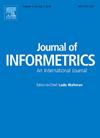团队规模及其对中断指数的负面影响
IF 3.5
2区 管理学
Q2 COMPUTER SCIENCE, INTERDISCIPLINARY APPLICATIONS
引用次数: 0
摘要
随着科学从孤独天才的时代过渡到合作团队的时代,大型团队能否维持个人的创造力并继续推动创新的问题变得越来越重要。我们之前的研究首先揭示了团队规模与颠覆指数之间的负相关关系——颠覆指数是一种基于引用网络的创新指标——通过分析半个多世纪以来的6500万个项目,包括论文、专利和软件。这项工作在科学界引发了激烈的辩论,讨论了颠覆指数在捕捉团队规模对创新的影响方面的稳健性。在这里,我们提供了额外的证据,证明团队规模和中断之间存在负相关关系,即使考虑到参考文献长度、引用影响和历史时间等因素。我们进一步展示了衡量颠覆性的5年窗口是如何将这种关系错误地描述为积极的,低估了小团队的长期颠覆性潜力。就像“睡美人”一样,小团队需要十年或更长的时间来展示他们对科学的变革性贡献。本文章由计算机程序翻译,如有差异,请以英文原文为准。
Team size and its negative impact on the disruption index
As science transitions from the age of lone geniuses to an era of collaborative teams, the question of whether large teams can sustain the creativity of individuals and continue driving innovation has become increasingly important. Our previous research first revealed a negative relationship between team size and the Disruption Index—a citation network-based metric of innovation—by analyzing 65 million projects across papers, patents, and software over half a century. This work has sparked lively debates within the scientific community about the robustness of the Disruption Index in capturing the impact of team size on innovation. Here, we present additional evidence that the negative link between team size and disruption holds, even when accounting for factors such as reference length, citation impact, and historical time. We further show how a narrow 5-year window for measuring disruption can misrepresent this relationship as positive, underestimating the long-term disruptive potential of small teams. Like “sleeping beauties,” small teams need a decade or more to reveal their transformative contributions to science.
求助全文
通过发布文献求助,成功后即可免费获取论文全文。
去求助
来源期刊

Journal of Informetrics
Social Sciences-Library and Information Sciences
CiteScore
6.40
自引率
16.20%
发文量
95
期刊介绍:
Journal of Informetrics (JOI) publishes rigorous high-quality research on quantitative aspects of information science. The main focus of the journal is on topics in bibliometrics, scientometrics, webometrics, patentometrics, altmetrics and research evaluation. Contributions studying informetric problems using methods from other quantitative fields, such as mathematics, statistics, computer science, economics and econometrics, and network science, are especially encouraged. JOI publishes both theoretical and empirical work. In general, case studies, for instance a bibliometric analysis focusing on a specific research field or a specific country, are not considered suitable for publication in JOI, unless they contain innovative methodological elements.
 求助内容:
求助内容: 应助结果提醒方式:
应助结果提醒方式:


